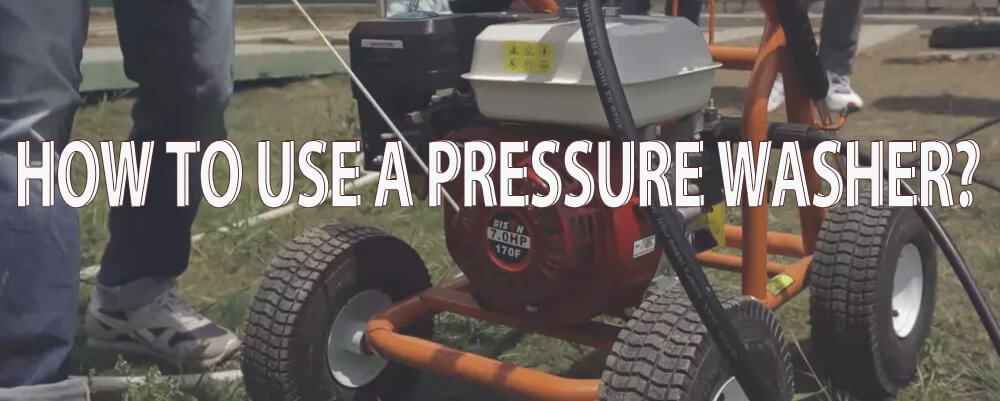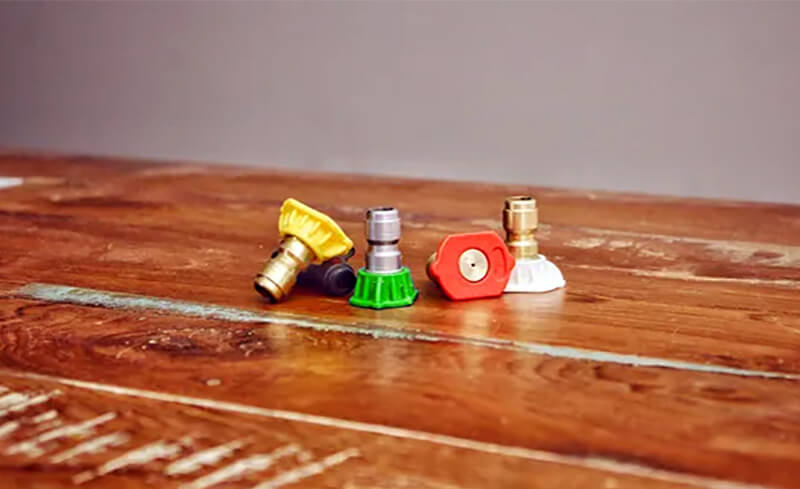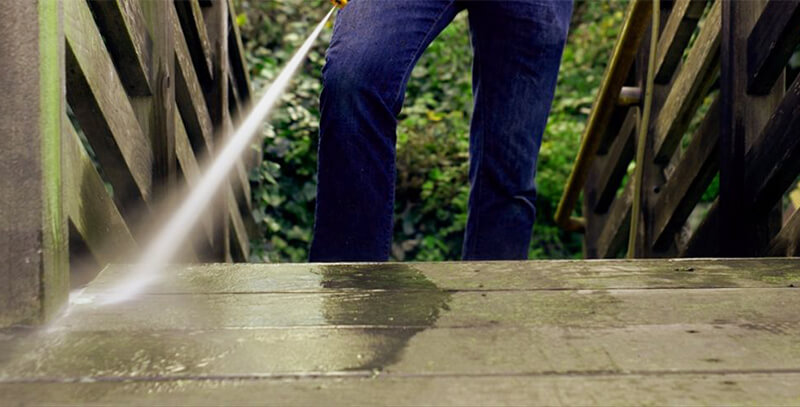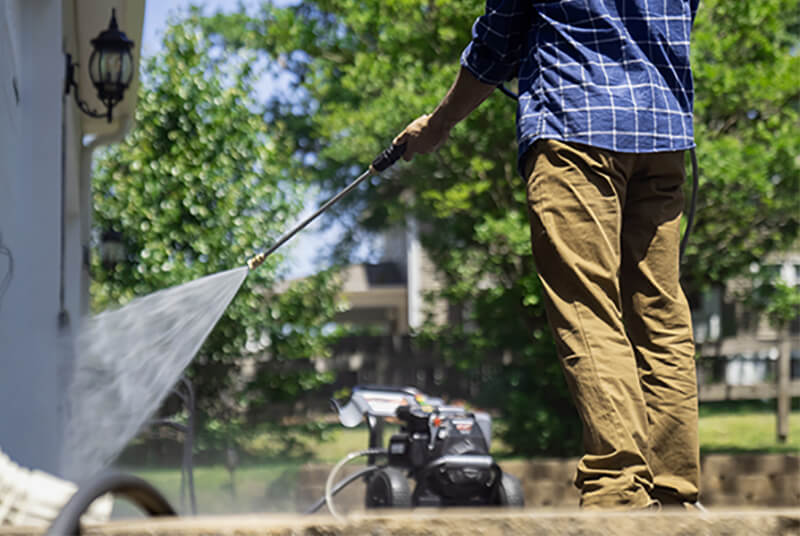15Nov 2023
table of contents

Pressure washers are one of the best tools for cleaning exterior surfaces. They are faster and more effective than old-fashioned brushes. However, since they produce high pressure, you must know how to operate them properly before you begin.
Begin by moving items such as potted plants, patio furniture, and other accessories from the cleaning area. Sweep up large debris, such as rocks and twigs, that can become projectiles when sprayed. Cover nearby plants and landscaping with a cover and tarp, outdoor lights, sound systems, or other features if they are in the direct water path or could receive significant spray.
The exterior of the house and garage require extra consideration. Close windows and doors, and if possible, cover outlets, light fixtures, doorbells, and air conditioning units with plastic or tarps and duct tape. Turn off the power to the external outlets of the section you are pressure washing. The goal is to prevent water from entering your home and prevent water and electricity from mixing.
If there are cracks or gaps in the area, such as missing mortar or dents in fencing, consider patching them before pressure washing. This can protect its structural integrity and prevent water from getting behind the protective outer covering.
Consult the manufacturer's instructions for assembling the pressure washers. Attach any extensions or telescoping wands you want to use. These are popular accessories for cleaning high, hard-to-reach siding. For gas-powered models, ensure to add fuel and lubricant as directed.
Find a hose (make sure there are no leakages) that will connect the pressure washer to your home's water supply. If using a cleaning solution, collect enough soap and the necessary supplies to apply it. Use safety glasses and closed-toe shoes to protect yourself from splashback or accidentally sweeping powerful water vapor across your toes.
Having sufficient fuel and oil on hand for gas models can also prevent project interruptions. (and to avoid damage to pressure washer machine).
Pressure washers come with multiple nozzles (although some machines have adjustable nozzles with different spray settings), controlling how the water goes from the pressure washer. Washer nozzles are usually universal in color and degree, and machines may come with some or all of the following:
0-Degree spray (red)
The most powerful spray, this is less commonly used and is not recommended for general exterior home cleaning projects.
15-degree spray (yellow)
It is suitable for hard surfaces and tough jobs like stripping paint.
25-degree spray (green)
Suitable for concrete and rigid, unpainted siding.
40-degree spray (white)
Suitable for damage-prone soft surfaces and most sidings
Low-pressure soap/detergent nozzle (color varies)

Smaller degree nozzles offer a stronger, more direct spray. Larger degrees have a broader, less concentrated force, making them safer on more surfaces. Home exterior projects typically use a low-pressure soap nozzle and a 25- or 40-degree spray.
Connect a standard garden hose to the home's supply of water and run it for 30-60 seconds to remove air and trapped material. Close the stopper, then connect the other end of the hose to the water supply on the pressure washers.
A washer needs constant pressure from your home's water source to operate smoothly. Use a water pressure gauge attached to the fixture to test the efficiency of your fountain. The device should work fine if it measures between 40 and 60 PSI.
Ensure your safety by promptly putting on your protective gear if you haven't done so already. Next, attach a low-pressure nozzle to the end of the pressure washer's wand. It should click into place easily. Turn on the water supply by fully opening the fixture. Aiming in a safe direction, release the trigger lock of the pressure washer and squeeze the trigger to purge air from the setup, continuing until water comes out of the wand.
Now, it is time to turn on the pressure washer. This is as simple as an off-on switch for most electric models, while gas-powered machines use a fuel choke, valve, and starter.More on the detailed process of "how to start high pressure washer". But turn on the pressure washer when you're ready to start. Going too long without using the machine is terrible.

According to the manufacturer's instructions, prepare and apply the cleaning solution. If using a pressure washer to apply detergent, make sure you add it (through the siphon tube or into the machine tank) as directed and that the low-pressure detergent nozzle is in place.
For vertical surfaces such as siding, fences, sloped driveways, or landscape steps, apply the cleaning solution from the bottom up, sweeping from side to side so that the soap runs downward and keeps the areas below wet. The manufacturer's instructions will advise how long to let the soap sit before washing.
Turn the machine on, unlock and engage the trigger to activate the pressure washer, and select a small area to test the pressure first. For something like siding, start with the nozzle at least four feet off the surface so as not to apply too much pressure immediately. For decking or horizontal surfaces, spray far before you, not directly down. Walk in close and adjust the angle you're holding the stick until the surface is clean but not damaged. Avoid bringing the nozzle too close to the surface.
If the existing setup isn't doing the trick, try changing the nozzle, being careful to start at a distance again. Nozzle tips should only be replaced if the engine is shut off, wand pressure is relieved, and the trigger is locked.
Once you find the correct position, clean up. Spray away from yourself, especially along the horizontal side of surfaces. For vertical surfaces, start from the top of the area you're working on, sweeping back and forth as you work your way down so that debris and dirt fall into regions waiting to be cleaned. For proper cleaning, use overlapping strokes, and don't linger with direct pressure on one spot. Avoid spraying directly on anything you have covered, such as light fixtures, outlets, and areas that can let water into the home, such as doors and windows. Do not use pressure washers around meters, satellites, cable boxes, power lines, or other utilities.
Repeat the soaping and washing as needed if you have divided your project into sections. Next, wash off any residue with a low-pressure, soapy nozzle or a hose connected to your home supply of water.
Engage the trigger safety lock and turn off the pressure washer after using it. After that, shut off the water supply. To discharge residual water and pressure from the nozzle, unlock the lock and turn on the wand. Consult the manufacturer's instructions for storing the machine.

Although concrete can collect dirt and debris quickly, it is not recommended to pressure wash any exterior of your home or office repeatedly. Overdoing it might weaken your concrete and increase the likelihood that pressure washing could damage and crack it.
Concrete cleaning requires powerful pressure washers with high-pressure levels of 3000 PSI. However, if you're using a power cleaner to maintain a range of surfaces other than concrete, choose one with adjustable pressure levels and around 3000 when you need to clean concrete.
Pressure washers are categorized into two main types: gas and electric.
Many examples of people trying to make their pressure washer soap using dish soap or laundry detergent. While using both of these in your pressure washer is possible, you risk clogging if you don't dilute them.
A pressure washer can significantly enhance your cleaning efforts, making them more efficient and effective. You can confidently tackle various cleaning tasks by following the steps outlined in this guide. Remember to prioritize safety, choose the proper nozzle and pressure settings for each job, and maintain an appropriate distance from the surface to be cleaned. Regular pressure washer maintenance will also ensure its longevity and optimal performance. Learn more about BISON pressure washers! welcome to inquire!
inquiry form here
BISON BLOG, All the latest news and views from Bison Machinery.
Related Articles
why does your pressure washer have surging or pulsing how to use soap on a pressure washer when to repair or replace pressure washer pump can you run a pressure washer without water why pressure washer won’t startRelated Products